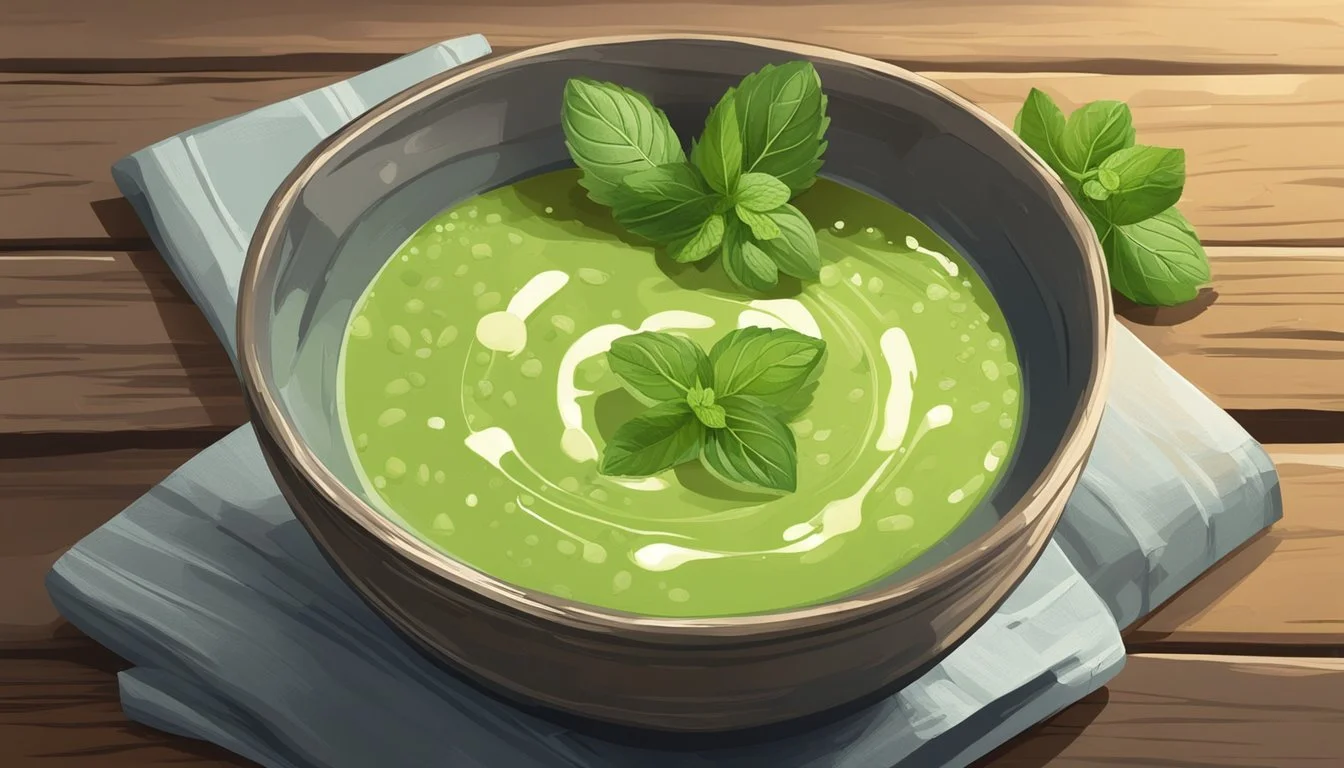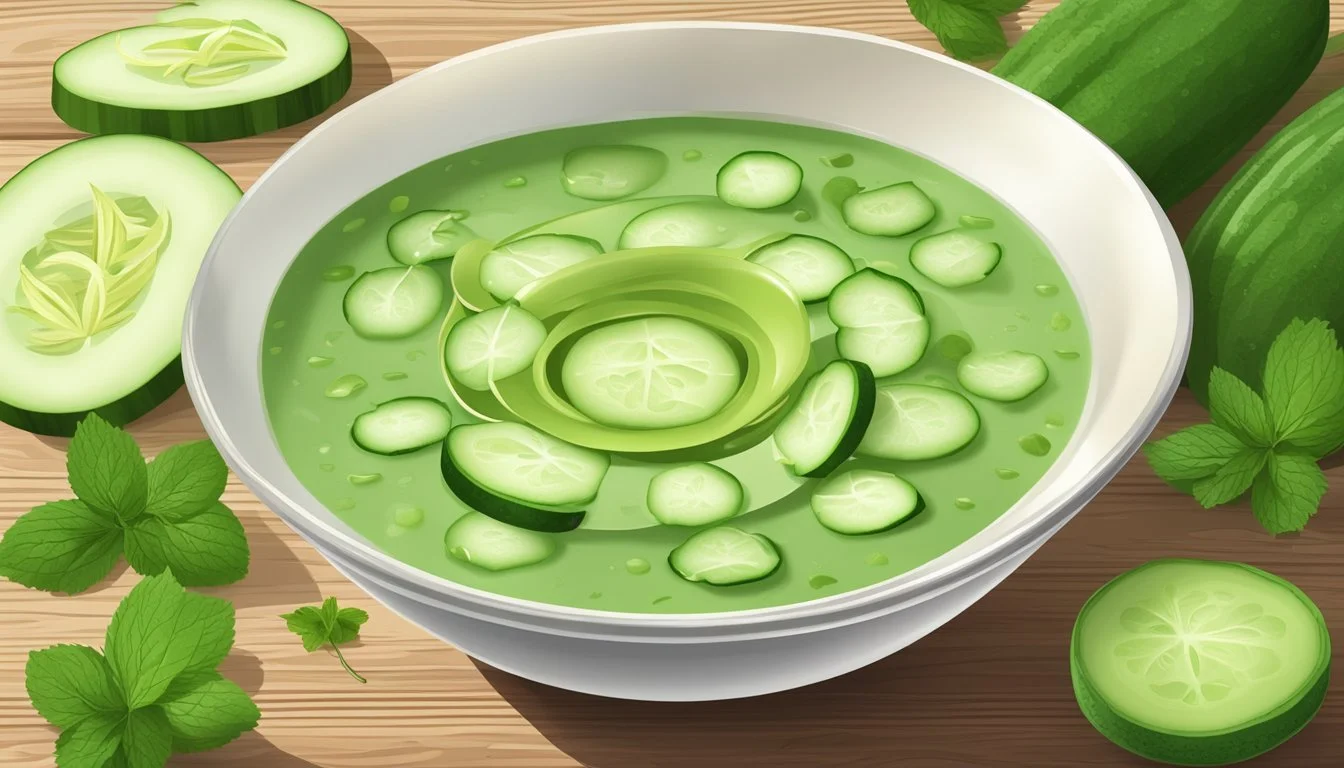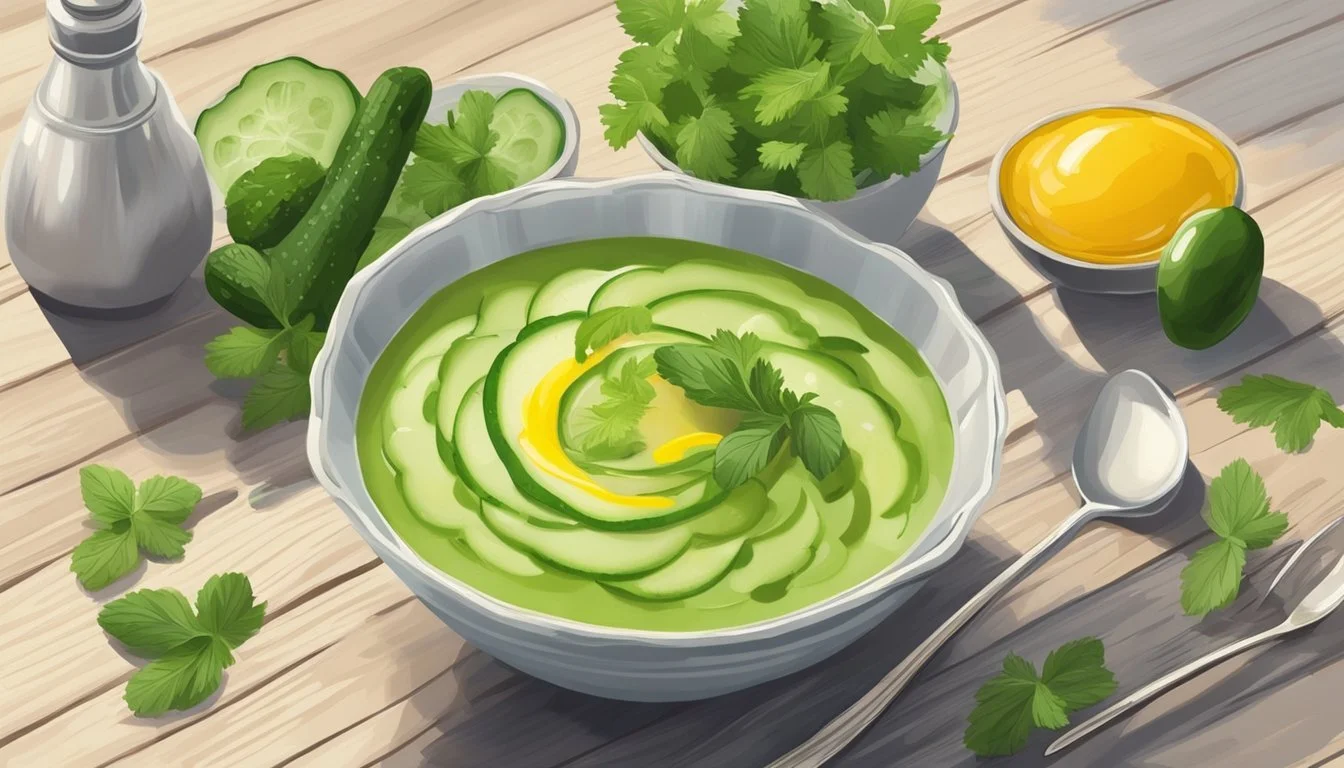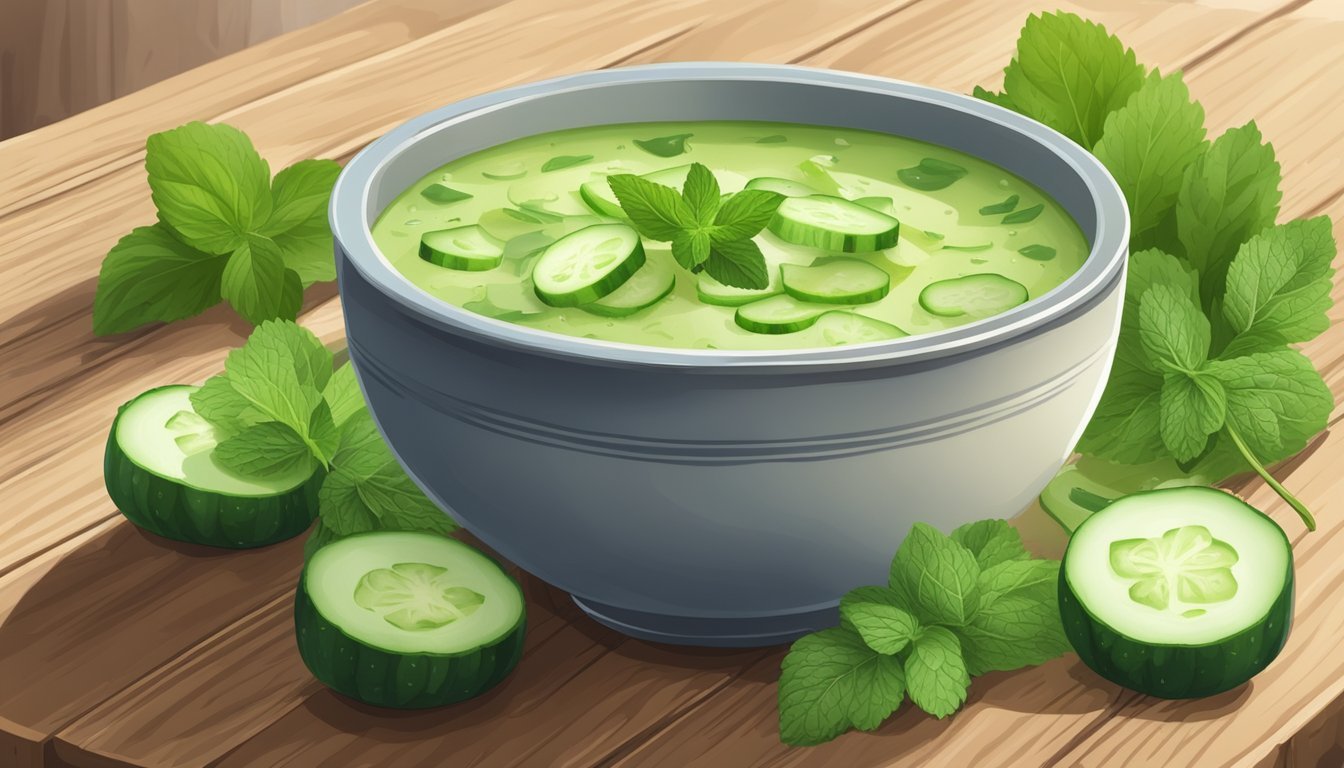Cucumber Peel Gazpacho
Delight in a Chilled, Summer-Perfect Soup
Cucumber Peel Gazpacho is a quintessential summer dish that captures the essence of refreshment. As temperatures rise, this cold soup serves as a perfect meal that not only cools the palate but also provides a healthy boost. Rich in water content and packed with nutrients, cucumbers—with their peel left on—add a vibrant green hue and a nutritional punch to the gazpacho. The retention of the peel ensures that fiber and vitamins are maximized, making this version of the gazpacho not just a delight to savor but also beneficial for one's well-being.
The process of making Cucumber Peel Gazpacho is both quick and easy, catering to the fast-paced lifestyle of many without compromising on flavor or health. The soup combines simple ingredients such as ripe tomatoes, crisp cucumbers, and a blend of aromatic seasonings, which, when pureed, result in a creamy and smooth consistency. No cooking is necessary, which not only preserves the freshness of the ingredients but also makes it an ideal dish for those sweltering days when standing by a hot stove is less than desirable.
This cold soup is versatile and lends itself to numerous garnishes, from fresh herbs to a dollop of sour cream, allowing for a personalized touch with each serving. Whether as a light standalone meal or a start to a summer feast, Cucumber Peel Gazpacho offers a cooling respite, embodying the ease and leisure of the season.
Historical Context
Gazpacho has evolved from a simple peasant dish to a sophisticated, global cuisine.
Origin of Gazpacho
Gazpacho originated in Southern Spain, a dish deeply embedded in its history and culture. It began as a rudimentary soup prepared by farmers and shepherds using accessible ingredients like old bread, garlic, olive oil, vinegar, and water. The genesis of gazpacho dates back to the 8th century during the Al-Andalus period, reflecting the culinary traditions of the region.
Evolution into Cucumber Gazpacho
Over time, gazpacho has seen numerous variations, one of which includes the advent of cucumber gazpacho. Cucumbers, with their cool and refreshing taste, were incorporated into traditional recipes, giving a lighter, creamier twist to the classic tomato-based version. This adaptation has been welcomed as a perfect summertime soup due to its refreshing qualities.
Health Benefits
Cucumber Peel Gazpacho offers a spectrum of health attributes ranging from its rich nutrient content to its hydrating properties. It caters to various dietary needs, being inherently dairy-free, gluten-free, and suitable for vegetarian and vegan diets.
Nutritional Information
Cucumber gazpacho is nutritionally dense, providing essential vitamins without excessive calories. Key nutrients include:
Vitamins: A significant source of Vitamin C, especially when lemon juice is added.
Minerals: Contains minerals such as potassium and manganese.
Hydration and Digestion
The high water content of cucumbers makes gazpacho inherently hydrating, which is beneficial for digestion. Additionally:
It's a gentle on the digestive system.
Contains fiber from cucumber peels, promoting digestive health.
Dietary Considerations
Cucumber Peel Gazpacho is versatile and caters to many dietary restrictions:
Dairy-free: Naturally free from dairy.
Gluten-free: Does not contain gluten ingredients.
Vegetarian/Vegan: Suitable for both vegetarian and vegan diets since it uses plant-based ingredients.
Key Ingredients
The essence of a refreshing Cucumber Peel Gazpacho lies in the freshness and quality of its key ingredients, which combine to create a harmonious blend of flavors and textures.
Cucumbers
Cucumbers are the star of gazpacho, providing a cool and hydrating base. For a more robust flavor and added nutritional value, it is advised to use English cucumbers with their peel on. This not only imparts a vibrant green color to the gazpacho but also enriches it with dietary fiber.
Types of cucumbers: English cucumber (with peel)
Preparation: Chopped
Tomatoes
Tomatoes add both liquid and a subtle acidity, giving the soup a well-rounded body. They are chosen for their ripe flavors that intensify during the peak of tomato season. Choosing juicy, ripe tomatoes can make a significant difference in the taste of the gazpacho.
Tomato preparation: Roughly chopped or blended
Texture contribution: Liquid and structure
Herbs and Seasonings
A variety of fresh herbs like basil, mint, cilantro, and parsley infuse the gazpacho with aromatic layers. Salt and pepper are essential, too, for they enhance the soup's flavors and bring the profile of the ingredients together.
Fresh Herbs: Basil, mint, cilantro, parsley (coarsely chopped)
Seasonings:
Salt (to taste)
Black pepper (freshly ground)
Oils and Acids
Olive oil, especially extra virgin, adds a hint of fruitiness and smoothness to the texture. Acids like vinegar, lemon juice, or lime juice are crucial for they brighten the overall flavor, contributing a mild tartness that complements the cucumbers and tomatoes.
Oils:
Olive oil or extra virgin olive oil (a drizzle for richness)
Acids:
Vinegar (for tanginess)
Lemon or lime juice (for a citrus note)
Preparation Techniques
In the process of creating a cucumber peel gazpacho, meticulous attention to preparation will ensure the flavors are vibrant and the texture is consistent. Below are precise methods for the initial peeling and chopping, efficient blending, and proper chilling and storage of the soup.
Peeling and Chopping
The first step in preparing cucumber gazpacho is to peel and chop the cucumbers. Peeling is optional but can influence the color of the gazpacho; peeled cucumbers lean towards a brighter green. For chopping, consistency is key for even blending later on. One should:
Peel the cucumbers with a vegetable peeler if a lighter color is desired.
Finely chop the cucumbers to ensure a smooth texture post-blending.
Blending Methods
A high-speed blender is essential for creating a creamy gazpacho. Each ingredient needs to be blended until the mixture is completely smooth. Steps to follow include:
Add the chopped cucumbers and other ingredients to the blender.
Blend on high speed until achieving a creamy, homogenous mixture.
Chilling and Storage
For optimal taste, cucumber gazpacho should be served cold. After blending, it is important to:
Pour the gazpacho into an airtight container to preserve freshness.
Chill in the refrigerator for 1-2 hours before serving.
To store, keep the gazpacho in the refrigerator to maintain its cool temperature and prevent spoilage. Always use an airtight container for storage to maintain flavor and freshness.
Gazpacho Variations
Gazpacho offers a canvas for creativity, allowing for diverse variants, from fruit infusions and vegetarian options to spicy tweaks. These variations maintain the cool, refreshing essence of the traditional soup while catering to various palates and dietary preferences.
Incorporating Fruits
Watermelon Gazpacho: This variation combines the crispness of cucumber with the sweet hydration of watermelon, delivering a summery twist.
Melon and Cucumber Blend: By integrating melon, chefs create a milder, subtly sweet gazpacho that complements the cucumber's freshness.
Vegan and Vegetarian Options
Avocado Enrichment: For a creamier texture without dairy, avocado can be blended into the gazpacho, enhancing its richness while keeping it vegan.
Vegetarian Toppings: Garnishes such as diced vegetables, fresh herbs, or a dollop of vegan sour cream can add contrast and elevate the dish.
Spicy Alternatives
Jalapeño Infusion: For those seeking heat, a jalapeño can be incorporated into the blend, its fiery kick cutting through the cool cucumber base.
Chilled Heat: A melody of spices, like cayenne pepper or diced chili peppers, can be added according to heat preference, offering a spicy yet refreshing option.
Serving Suggestions
Cucumber Peel Gazpacho is best enjoyed with thoughtful garnishes and accompaniments that enhance its delicate flavors and provide a satisfying texture contrast.
Garnishes
For an aesthetically pleasing and flavorful finish, a chef may consider a variety of garnishes that complement the cool, refreshing taste of Cucumber Peel Gazpacho. Here are specific suggestions:
Microgreens: A sprinkle adds both a subtle peppery flavor and a vibrant splash of color.
Edible Flowers: They infuse a floral hint and create an eye-catching presentation.
Chives: Sliced thinly, they lend a mild onion-like taste that doesn't overpower the soup.
Croutons: For a satisfying crunch, one could float a few homemade croutons atop the soup.
Accompaniments
To round out the meal, Cucumber Peel Gazpacho pairs well with various sides. The following are recommended:
Bread: A crusty baguette or slices of artisanal bread can be served on the side to sop up the soup.
Salad: A light salad with a citrus-based dressing can accompany the gazpacho for a refreshing meal.
Recipe Tips and Tricks
Creating the perfect Cucumber Peel Gazpacho involves a mix of preparation techniques and ingredient tweaks. This section provides guidance on making the soup ahead of time, enhancing its flavors, and suitable ingredient substitutions.
Making Ahead
The flavor of Cucumber Peel Gazpacho develops over time, making it an ideal dish to prepare in advance. For optimal taste, one can blend the soup and store it in the refrigerator for up to 8 hours. This resting period allows the ingredients to meld, resulting in a more cohesive flavor profile. For a quick chill, they may add ice cubes directly to the blender, ensuring the gazpacho is cold upon serving.
Flavor Enhancements
To elevate the gustatory experience of Gazpacho, consider these additions:
Acid: A splash of vinegar or citrus juice can provide a bright, acidic note.
Herbs: Fresh herbs like basil or dill can add a layer of complexity.
Heat: A hint of spice from jalapeños or red pepper flakes can offer a subtle kick.
Pro Tip: Adjust these enhancements gradually, tasting as one goes, to avoid overpowering the delicate cucumber flavor.
Substitutions
Dietary preferences or restrictions may necessitate substitutions. Here are a few options:
Creamy Elements: When sour cream is necessary, use Greek yogurt or coconut yogurt for a healthier alternative. These substitutes maintain the creamy texture while offering varying degrees of tanginess and richness.
Original Ingredient Substitution Options Sour Cream Greek Yogurt, Coconut Yogurt
Yogurt: Should a recipe call for regular yogurt, one can use Greek yogurt for a thicker, protein-rich option, or coconut yogurt to keep it dairy-free.
Note: Substitutions may alter the final taste and consistency, so they should be made considering personal preference and dietary needs.
Frequently Asked Questions
In this section, readers will find solutions to common issues they might encounter while preparing cucumber peel gazpacho, alternative equipment they can use, and details regarding nutritional concerns.
Common Issues
Blender vs. Food Processor: While both appliances can be used to make gazpacho, a high-speed blender is generally preferred for a smoother consistency. However, one can utilize a food processor if a chunkier texture is desired.
Serving Size Discrepancy: It's important to note that serving sizes can vary. Typical recipes serve between four to six people, but individual preferences for soup thickness or added ingredients can alter the expected yield.
Alternative Equipment
When a Blender isn't Available: If a blender is not at hand, a food processor can serve as a substitute, albeit resulting in less smoothness. As a last resort, finely dicing the ingredients and mixing them thoroughly by hand is a time-honored traditional method.
Nutritional Concerns
Nutrition Information: The primary ingredients in cucumber peel gazpacho, such as fresh cucumbers, tomatoes, and herbs, contribute to a low-calorie, nutrient-dense dish that's high in vitamins and antioxidants.
Calories: Typically low
Fat: Low (unless oil is used generously)
Carbohydrates: Moderate, mainly from vegetables
Protein: Low
Fiber: High, due to vegetables and cucumber peels
Allergies and Dietary Restrictions: This cold soup is inherently gluten-free and can be easily adapted for vegan diets by omitting any dairy garnish or substituting with plant-based alternatives.
Final Thoughts
Cucumber Gazpacho stands out as a quintessential summer soup, offering both coolness and a palatable zest. As a no-cook option, it allows chefs and home cooks alike to keep their kitchens cool while preparing a nutritious dish. The recipe's simplicity leans on the natural flavors of fresh vegetables, where cucumbers are the star—bestowing a refreshing burst with each spoonful.
They often choose to underline the soup's vibrance by leaving the cucumber peel on, ensuring that the visual appeal matches the taste. Considering food sensitivities, the gazpacho can be customized; for instance, it's easy to modify to remain gluten-free or vegan without compromising the taste. It’s a versatile dish that can be adapted to include various garnishes or additional ingredients, such as:
Sour cream or yogurt (vegan options available)
Herbs like cilantro or parsley
Crunchy toppings like croutons or seeds
Moreover, the nutritional profile of cucumber isn't lost on health-conscious individuals. The high water content assists in hydration, while the presence of various vitamins and minerals supports overall health.
In creating a batch of Cucumber Gazpacho, one taps into the essence of summer—capturing coolness and lightness in a bowl. It’s an invitation to savor the warmer months, to indulge in simplicity, and to embrace the joy of eating foods that are as healthful as they are delicious.









